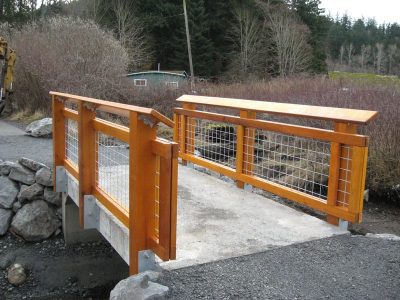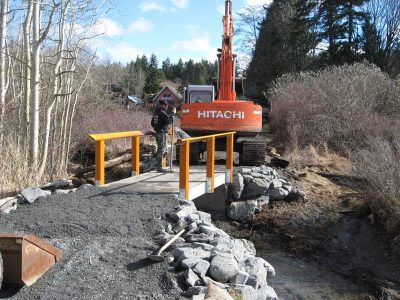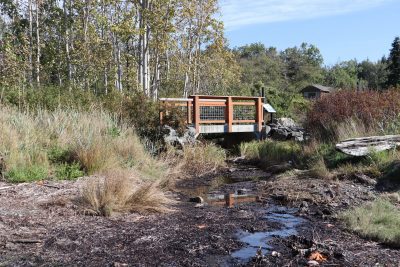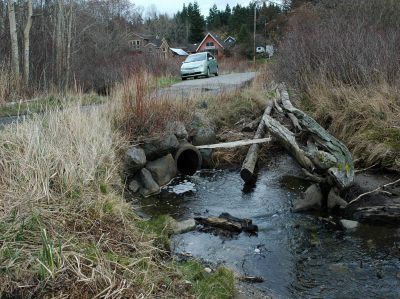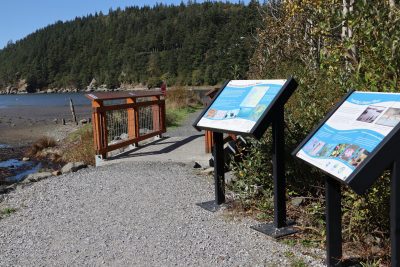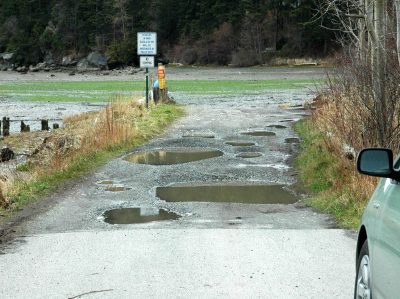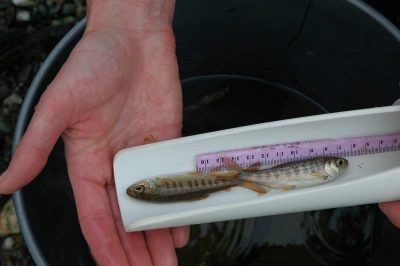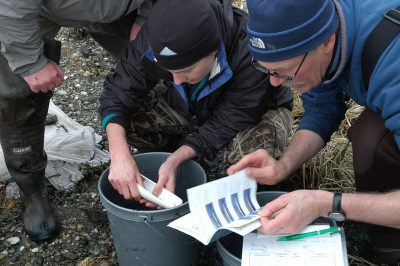Restoration of the Chuckanut Village Marsh has enhanced the area’s ability to provide pocket estuary functions, including improving water quality and providing rearing, foraging and osmo-regulation for juvenile salmonids migrating from nearby Chuckanut Creek. The project involved:
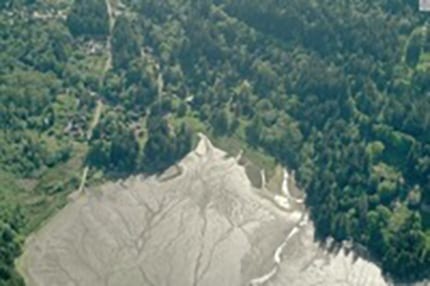
- Replacing an undersized culvert with a much larger box culvert to increase the tidal exchange between the marsh and the bay;
- Creating an ADA accessible path to the shoreline from the end of Fairhaven Ave.;
- Re-establishing a native salt marsh buffer along the publicly owned sections of the shoreline;
- Protecting native vegetation and habitat elements by restricting vehicle access to sections of the shoreline and intertidal zones;
- Relocating parking away from the shoreline;
- Educating the public about the importance of marine nearshore environments, with the end goal of producing behavioral change that promotes a healthy nearshore habitat.
Construction Photos
Chuckanut Bay Habitat
Chuckanut Bay is one of seven pocket estuaries found within Bellingham Bay. Pocket estuaries are shallow, low energy shoreline areas that range from the mouths of small streams and creeks (such as Chuckanut Creek) to nearly enclosed bays and lagoons (such as Padden lagoon).
They can be composed of habitats such as unvegetated mud flats, salt marsh, tidal channels and estuarine wetlands. Cumulatively, pocket estuaries are very important to several life history stages of juvenile chum salmon and federally listed juvenile Chinook and steelhead salmon. Chuckanut Bay and adjacent lands also provide habitat for many species of wildlife, including Great Blue Heron.
Chuckanut Village Marsh restoration was proposed based on an understanding of the ecological importance of this type of habitat and its scarcity locally. Numerous technical assessments attest to the importance of this type of marine habitat.
Chuckanut Village Marsh Restoration Steps
The City’s consulting team, Coastal Geologic Services, developed a final design for Alternative #1 and incorporated as many community comments into the chosen alternative as possible.
Construction occurred in 2011 after local, state and federal permits were obtained. Funding for design and permitting was from Whatcom County Marine Resources Committee via Whatcom County. Funding for construction was through a grant from Washington State Department of Ecology.
Public Involvement in Restoration Plans
The City held a series of public meetings in Spring 2009 regarding the Chuckanut Village Marsh restoration project. Three conceptual alternatives were presented at the meetings along with several blank maps for community members to design other alternatives. Forty-five people commented during the public comment period. Of those stating a preference for one design alternative, a significant majority preferred Design Alternative #1.
Additional Information
Project Documents
- Chuckanut Village Marsh Restoration Project Final Plans (PDF)
- Chuckanut Village Marsh Plan Revision 11-09-09 (PDF)
- Chuckanut Village Marsh Water Quality Report 2013 (PDF)
- Chuckanut Village Marsh Follow-up Community Survey 2013 (PDF)
- Chuckanut Village Marsh Baseline Community Survey, 2010 (PDF)
- Chuckanut Village Marsh Final Plans, October 2009 (PDF)
- Preferred Alternative – Beach Plan (PDF)
- Preferred Alternative – Brackish Region (PDF)
- Preferred Alternative – Parking (PDF)
- Project Overview (PDF)
- Project Alternatives (PDF)
- Public Process (PDF)
- Public Access Map (PDF)
- April 7, 2009 Meeting – Power Point (PDF)
- April 7, 2009 Meeting – Public Comments (PDF)
Studies
- Wetland Characterization Chuckanut Village Marsh – June 2008 (PDF)
- Nearshore Habitat Restoration Prioritization – Whatcom County, June 2007 (PDF)
- Management of City of Bellingham Pocket Estuaries – February 2006 (PDF)
- Importance of Pocket Estuaries – Beamer, May 2003 (PDF)
- Fairhaven Avenue Wetland Delineation Report 2009 (PDF)
Project Contact: Analiese Burns, Habitat and Restoration Manager, Public Works Department, Natural Resources. (360) 778-7968, acburns@cob.org


